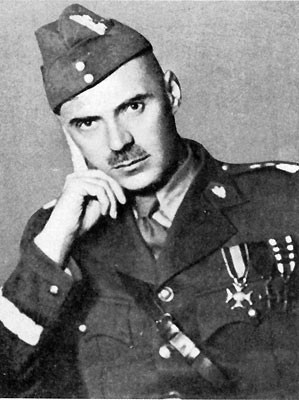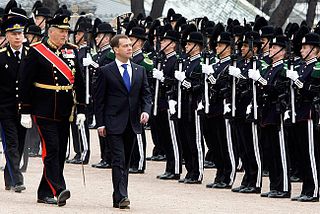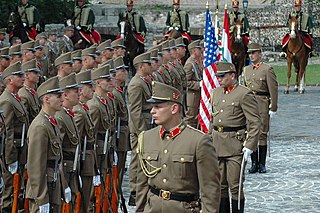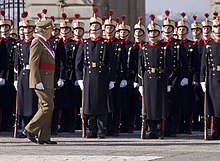
A battalion is a military unit, typically consisting of 300 to 1,000 soldiers commanded by a lieutenant colonel, and subdivided into a number of companies. The typical battalion is built from three operational companies, one weapons company and one HQ company. In some countries, battalions are exclusively infantry, while in others battalions are unit-level organisations.

The Polish II Corps, 1943–1947, was a major tactical and operational unit of the Polish Armed Forces in the West during World War II. It was commanded by Lieutenant General Władysław Anders and fought with distinction in the Italian Campaign, in particular at the Battle of Monte Cassino. By the end of 1945, the corps had grown to well over 100,000 soldiers.

In some militaries, foot guards are senior infantry regiments. Foot guards are commonly responsible for guarding royal families or other state leaders, and they also often perform ceremonial duties accordingly, but at the same time are combat soldiers.

A royal guard is a group of military bodyguards, soldiers or armed retainers responsible for the protection of a royal family member, such as the emperor or empress, king or queen, or prince or princess. They often are an elite unit of the regular armed forces, or are designated as such, and may maintain special rights or privileges.

The Government Palace, also known as the House of Pizarro, is the seat of the executive branch of the Peruvian government, and the official residence of the president of Peru. The palace is a stately government building, occupying the northern side of the Plaza Mayor in Peru's capital city, Lima. Set on the Rímac River, the palace occupies the site of a very large huaca that incorporated a shrine to Taulichusco, the last kuraka of Lima.

The United States Cavalry, or U.S. Cavalry, was the designation of the mounted force of the United States Army by an act of Congress on 3 August 1861. This act converted the U.S. Army's two regiments of dragoons, one regiment of mounted riflemen, and two regiments of cavalry into one branch of service. The cavalry branch transitioned to the Armored Forces with tanks in 1940, but the term "cavalry", e.g. "armored cavalry", remains in use in the U.S. Army for mounted reconnaissance, surveillance, and target acquisition (RSTA) units based on their parent Combat Arms Regimental System (CARS) regiment. Cavalry is also used in the name of the 1st Cavalry Division for heraldic/lineage/historical purposes. Some combined arms battalions are designated as armor formations, while others are designated as infantry organizations. These "branch" designations are again, heraldic/lineage/historical titles derived from the CARS regiments to which the battalions are assigned.

The Mexican Army is the combined land and air branch and is the largest part of the Mexican Armed Forces; it is also known as the National Defense Army.
Reconnaissance, surveillance, and target acquisition (RSTA) refers to a joint doctrine of reconnaissance, surveillance and target acquisition conducted by the United States Armed Forces. RSTA operations are designed to support military operations at a strategic, operational, or tactical level, either by dedicated RSTA forces or those which possess the capability.

The King's Guard is a ceremonial designation given by the Monarchy of Thailand to the various units within the Royal Thai Armed Forces. Practical and real security of the Royal family has since 1992 been provided by the Royal Security Command, which is an agency that is completely independent of the armed forces.

A guard of honour (GB), also honor guard (US), also ceremonial guard, is a group of people, usually military in nature, appointed to receive or guard a head of state or other dignitaries, the fallen in war, or to attend at state ceremonials, especially funerals. In military weddings, especially those of commissioned officers, a guard, composed usually of service members of the same branch, form the sabre arch. In principle, any military unit could act as a guard of honour. However, in some countries certain units are specially designated to serve as a guard of honour, as well as other public duties. Republican Guards, Royal Guards and foot guards frequently have ceremonial duties assigned to them.

44th Parachute Brigade was a British Army Territorial Army parachute brigade, active from c.1950 to 1978.
This is the Operation Herrick ground order of battle, which lists any British ground forces that have taken part in the duration of Operation Herrick between 2002 and 2014.

In the United States (US) military, a beret flash is a shield-shaped embroidered cloth that is typically 2.25 in (5.72 cm) tall and 1.875 in (4.76 cm) wide with a semi–circular base that is attached to a stiffener backing of a military beret. These flashes—a British English word for a colorful cloth patch attached to military headgear—are worn over the left eye with the excess cloth of the beret shaped, folded, and pulled over the right ear giving it a distinctive appearance.

The 106th Cavalry Regiment was a mechanized cavalry unit of the United States Army in World War II recognized for its outstanding action. The group was organized in 1921 as part of the Illinois National Guard and during the Spanish–American War and World War I was known as the 1st Regiment Illinois Volunteer Cavalry. It underwent a number of reorganizations before World War II. Like other Guard units during the inter-war years, the 106th held weekly or monthly drills and yearly training. Readiness for war in 1940 led to the mechanization of the unit and induction into Federal service at Camp Livingston, Louisiana on 25 November 1940.

The Republican Guard of Peru was a branch of the Peruvian National Gendarmerie responsible for providing security to the headquarters of public institutions and penitentiary establishments, as well as border control.

The Berlin Infantry Brigade was a British Army brigade-sized garrison based in West Berlin during the Cold War. After the end of World War II, under the conditions of the Yalta and Potsdam agreements, the Allied forces occupied West Berlin. This occupation lasted throughout the Cold War. The French Army also had units in Berlin, called the French Forces in Berlin and the US Army's unit in Berlin was the Berlin Brigade.
The Northern Army Group (NORTHAG) was a NATO military formation comprising five Army Corps from five NATO member nations. During the Cold War NORTHAG was NATO's forward defence in the Northern half of the Federal Republic of Germany (FRG). The Southern half of the Federal Republic of Germany was to be defended by the four Army Corps of NATO's Central Army Group (CENTAG). During wartime NORTHAG would command four frontline corps and one reserve corps. Air support was provided by Second Allied Tactical Air Force.

Spanish military units have coats of arms, badges and emblems to distinguish them from other units both joint Armed Forces and service branches units.
The following is a hierarchical outline for the structure of the British Army in 1989. The most authoritative source for this type of information available is Ministry of Defence, Master Order of Battle, and United Kingdom Land Forces, HQ UKLF, UKLF ORBAT Review Action Plan, HQ UKLF, 1990.





































